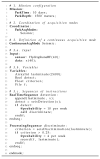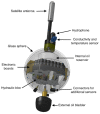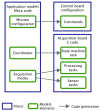MeLa: A Programming Language for a New Multidisciplinary Oceanographic Float
- PMID: 33114608
- PMCID: PMC7672633
- DOI: 10.3390/s20216081
MeLa: A Programming Language for a New Multidisciplinary Oceanographic Float
Abstract
At 2000 m depth in the oceans, one can hear biological, seismological, meteorological, and anthropogenic activity. Acoustic monitoring of the oceans at a global scale and over long periods of time could bring important information for various sciences. The Argo project monitors the physical properties of the oceans with autonomous floats, some of which are also equipped with a hydrophone. These have a limited transmission bandwidth requiring acoustic data to be processed on board. However, developing signal processing algorithms for these instruments requires one to be an expert in embedded software. To reduce the need of such expertise, we have developed a programming language, called MeLa. The language hides several aspects of embedded software with specialized programming concepts. It uses models to compute energy consumption, processor usage, and data transmission costs early during the development of applications; this helps to choose a strategy of data processing that has a minimum impact on performances. Simulations on a computer allow for verifying the performance of the algorithms before their deployment on the instrument. We have implemented a seismic P wave detection and a blue whales D call detection algorithm with the MeLa language to show its capabilities. These are the first efforts toward multidisciplinary monitoring of the oceans, which can extend beyond acoustic applications.
Keywords: Digital Signal Processing; Domain Specific Language; Model Based Programming; Model Driven Engineering; acoustic monitoring; embedded software; embedded system; oceanography.
Conflict of interest statement
The authors declare no conflict of interest.
Figures












References
-
- Wüst G. The major deep-sea expeditions and research vessels 1873–1960: A contribution to the history of oceanography. Prog. Oceanogr. 1964;2:1–52. doi: 10.1016/0079-6611(64)90002-3. - DOI
-
- Marcelli M., Piermattei V., Zappalà G. Advances in low cost marine technologies. WIT Trans. Mod. Sim. 2011;51:497–507.
-
- Venkatesan R., Ramesh K., Kishor A., Vedachalam N., Atmanand M.A. Best Practices for the Ocean Moored Observatories. Front. Mar. Sci. 2018;5:469. doi: 10.3389/fmars.2018.00469. - DOI
-
- Meindl A. Guide to Moored Buoys and Other Ocean Data Acquisition Systems. [(accessed on 25 October 2020)];1996 WMO & IOC Data Buoy Cooperation Panel. Available online: https://library.wmo.int/index.php?lvl=notice_display&id=12444#.X5Wux1njKCO.
-
- Hello Y., Royer J.Y., Rivet D., Charvis P., Yegikyan M., Philippe O. New Versatile Autonomous Platforms for Long-Term Geophysical Monitoring in the Ocean; Proceedings of the OCEANS 2019; Marseille, France. 17–20 June 2019; [(accessed on 14 October 2019)]. pp. 1–8. Available online: https://ieeexplore.ieee.org/abstract/document/8867216.
LinkOut - more resources
Full Text Sources
Miscellaneous

